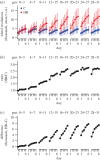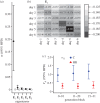Evolution of the additive genetic variance-covariance matrix under continuous directional selection on a complex behavioural phenotype
- PMID: 26582016
- PMCID: PMC4685799
- DOI: 10.1098/rspb.2015.1119
Evolution of the additive genetic variance-covariance matrix under continuous directional selection on a complex behavioural phenotype
Abstract
Given the pace at which human-induced environmental changes occur, a pressing challenge is to determine the speed with which selection can drive evolutionary change. A key determinant of adaptive response to multivariate phenotypic selection is the additive genetic variance-covariance matrix ( G: ). Yet knowledge of G: in a population experiencing new or altered selection is not sufficient to predict selection response because G: itself evolves in ways that are poorly understood. We experimentally evaluated changes in G: when closely related behavioural traits experience continuous directional selection. We applied the genetic covariance tensor approach to a large dataset (n = 17 328 individuals) from a replicated, 31-generation artificial selection experiment that bred mice for voluntary wheel running on days 5 and 6 of a 6-day test. Selection on this subset of G: induced proportional changes across the matrix for all 6 days of running behaviour within the first four generations. The changes in G: induced by selection resulted in a fourfold slower-than-predicted rate of response to selection. Thus, selection exacerbated constraints within G: and limited future adaptive response, a phenomenon that could have profound consequences for populations facing rapid environmental change.
Keywords: Bulmer effect; G-matrix; experimental evolution; genetic covariance tensor; selection limit; wheel running.
© 2015 The Author(s).
Figures



Similar articles
-
Limits to behavioral evolution: the quantitative genetics of a complex trait under directional selection.Evolution. 2013 Nov;67(11):3102-19. doi: 10.1111/evo.12200. Epub 2013 Jul 23. Evolution. 2013. PMID: 24151996
-
Phenotypic plasticity and experimental evolution.J Exp Biol. 2006 Jun;209(Pt 12):2344-61. doi: 10.1242/jeb.02244. J Exp Biol. 2006. PMID: 16731811 Review.
-
Can a Hybrid Line Break a Selection Limit on Behavioral Evolution in Mice?Behav Genet. 2025 Jan;55(1):43-58. doi: 10.1007/s10519-024-10209-7. Epub 2024 Dec 5. Behav Genet. 2025. PMID: 39636486 Free PMC article.
-
Ontogenies in mice selected for high voluntary wheel-running activity. I. Mean ontogenies.Evolution. 2003 Mar;57(3):646-57. doi: 10.1111/j.0014-3820.2003.tb01556.x. Evolution. 2003. PMID: 12703954
-
Environmental effects on the structure of the G-matrix.Evolution. 2015 Nov;69(11):2927-40. doi: 10.1111/evo.12795. Evolution. 2015. PMID: 26462609 Review.
Cited by
-
Conserved G-matrices of morphological and life-history traits among continental and island blue tit populations.Heredity (Edinb). 2017 Aug;119(2):76-87. doi: 10.1038/hdy.2017.15. Epub 2017 Apr 12. Heredity (Edinb). 2017. PMID: 28402327 Free PMC article.
-
Divergence in evolutionary potential of life history traits among wild populations is predicted by differences in climatic conditions.Evol Lett. 2024 Feb 1;8(1):29-42. doi: 10.1093/evlett/qrad067. eCollection 2024 Feb. Evol Lett. 2024. PMID: 38370542 Free PMC article.
-
Experimental evolution of a pheromone signal.Ecol Evol. 2022 May 24;12(5):e8941. doi: 10.1002/ece3.8941. eCollection 2022 May. Ecol Evol. 2022. PMID: 35646318 Free PMC article.
-
Adaptive radiation along a deeply conserved genetic line of least resistance in Anolis lizards.Evol Lett. 2018 Jul 17;2(4):310-322. doi: 10.1002/evl3.72. eCollection 2018 Aug. Evol Lett. 2018. PMID: 30283684 Free PMC article.
-
Genetic adaptation as a biological buffer against climate change: Potential and limitations.Integr Zool. 2018 Jul;13(4):372-391. doi: 10.1111/1749-4877.12298. Integr Zool. 2018. PMID: 29168625 Free PMC article. Review.
References
-
- Walsh B, Blows MW. 2009. Abundant genetic variation + strong selection = multivariate genetic constraints: a geometric view of adaptation. Annu. Rev. Ecol. Syst. 40, 41–59. (10.1146/annurev.ecolsys.110308.120232) - DOI
Publication types
MeSH terms
LinkOut - more resources
Full Text Sources
Other Literature Sources

